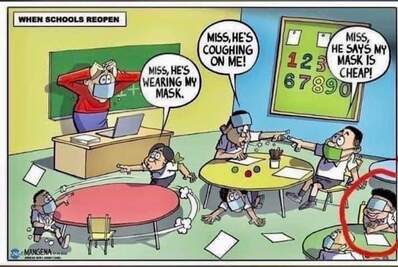 On May 19th, the CDC released guidelines for school attendance during the COVID-19 pandemic. The CDC outlined three possible scenarios and included the risks of each situation. The three scenarios included: Lowest Risk: Students and teachers engage in virtual-only classes, activities, and events. More Risk: Small, in-person classes, activities, and events. Groups of students stay together and with the same teacher throughout/across school days, and groups do not mix. Students remain at least 6 feet apart and do not share objects (e.g., hybrid virtual and in-person class structures or staggered/rotated scheduling to accommodate smaller class sizes). Highest Risk: Full-sized, in-person classes, activities, and events. Students are not spaced apart, share classroom materials or supplies, and mix between classes and activities. By late June, three schools had rolled out their fall school opening plans giving parents a choice between digital, in-person, and a hybrid model. The proposal came after both parent and staff surveys, but the announcements shocked many. The last few months took parents through the burden of homeschooling, cancelation of graduations, and the worry of keeping their children safe during a pandemic. Now parents must decide how their child would learn for the next school year with very little information as to how it will look. As we walk into this great unknown, what can we do to be prepared and ensure our children have the best school experience possible? (https://www.cdc.gov/coronavirus/2019-ncov/community/schools-childcare/schools.html) When schools closed in March, there wasn't a single parent ready for the burden of digital learning. We scrambled to keep up with assignments and understand what in the world it all meant. The parents struggled, the students struggled, and we all felt like we had fallen down the rabbit hole, hoping to return home soon. As summer approached, it felt like we were free, and our "normal" would return. We celebrated the start of summer with all the hopes school in the fall would be the same as we left it, but we approach the start of school this fall it looks like we will have to accept a new "normal." That "normal" included parents having to decide how their children will receive their education for the next school year and the reality that the pandemic is still present. At the end of June, three counties had announced their plans for reopening. These plans included Hybrid, in-person or digital options. Ready or not, our students will return no later than August 17th. With this realization, parents want to know how schools plan to keep our students and their staff safe. The state of Georgia does not require masks, but some school districts are strongly recommending it along with six feet of distance when possible. Decisions about restrictions during this pandemic change monthly, so there are still many unknowns. Districts have not given specific and definite guidelines on recess, PE, assemblies, Parent nights, etc. where crowds and distancing will be difficult. So how do we ensure our children will be safe. As a parent of elementary and a high school student and also an elementary teacher, I know that it will be hard to keep the little ones masked and apart from each other all day. It is important to make sure we implore our children to keep their safety in mind. Make sure they have personal cleansing and disinfecting materials, and keep in mind they need to stay distant from their friends when possible. Schools are not allowing sharing of materials, but children need to make sure they are not sharing personal materials like they may be used to. Just as we prepare our children for safety in any environment, we now have to prepare them to stay safe in school. Now that we have heard what the return of school may look like, how can we, as parents, ensure that our children are safe, and their educational needs are met? With information coming from every which way and changing weekly, we as parents will be our children's most important advocates. Schools will be working diligently to create environments that follow state guidelines while keeping student's academic needs in mind. Whether your child is attending a hybrid, in person, or digital format, it will be starkly different from what they have been used to. One possible concern with face to face or hybrid instruction might be the possibility of the necessary safety precautions posing an emotional an/or academic risk to a successful school year. In preparation for this possible concern, it is important to be aware of any and all safety measures your school will be implementing. Making your child is aware ahead of time can reduce any possible anxiety or fear. Knowing the school's safety measures will also help parents to feel empowered and in the know. It is important as an advocate to know what your child's academic needs are and how they will be met. It is ok to ask as many questions as you need to understand and support your child. These questions may help you understand…
Khadijah AbdullahI am am a wife mother of four and an elementary education teacher for Cobb County schools. I have spent the last four years advocating for children who have experienced adverse effects of trauma. I am a teacher trainer and curriculum developer striving to create curriculum for teachers and schools to better address students who are underserved. I am also the creative director of MACE (Muslim Advocated of Children with Exceptionalities), a group that strives to open avenues for special needs children and their families.
0 Comments
Leave a Reply. |
Don't miss another edition of A Message from Makkah. Click the button below to join our mailing list
Contact Us for Advertising Opportunities!
Archives
January 2023
Categories
All
Our Sponsors |
Makkah International Institute
 RSS Feed
RSS Feed